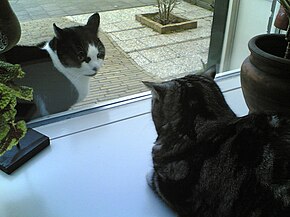
Cats communicate for a variety of reasons, including to show happiness, express anger, solicit attention, and observe potential prey. Additionally, they collaborate, play, and share resources. When cats communicate with humans, they do so to get what they need or want, such as food, water, attention, or play. As such, cat communication methods have been significantly altered by domestication.[1] Studies have shown that domestic cats tend to meow much more than feral cats.[2] They rarely meow to communicate with fellow cats or other animals. Cats can socialize with each other and are known to form "social ladders," where a dominant cat is leading a few lesser cats. This is common in multi-cat households.
Cats can use a range of communication methods, including vocal, visual, tactile and olfactory communication. Up to 21 different cat vocalizations have been observed.[3] They use visual signals, or body language, to express emotions like relaxation, fear, and aggression. Cats use several types of tactile behaviors to communicate, such as grooming or biting each other. They also use olfactory communication, such as marking their territory via urine.
- ^ Turner, Dennis C.; Bateson, Paul Patrick Gordon (2000-06-08). The Domestic Cat: The Biology of Its Behaviour. Cambridge University Press. ISBN 978-0-521-63648-3.
- ^ "How do cats communicate with each other?". Library of Congress, Washington, D.C. 20540 USA. Retrieved 2024-03-05.
- ^ Tavernier, Chloé; Ahmed, Sohail; Houpt, Katherine Albro; Yeon, Seong Chan (2020). "Feline vocal communication". Journal of Veterinary Science. 21 (1): e18. doi:10.4142/jvs.2020.21.e18. ISSN 1229-845X. PMC 7000907. PMID 32017479.